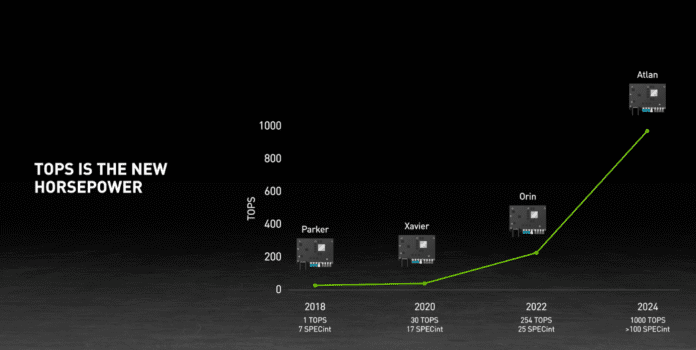At this year’s GTC, NVIDIA Founder and CEO Jensen Huang announced updates to its system-on-a-chip (SoC) for autonomous driving DRIVE Orin, as well as the unveiling of DRIVE Atlan, an AI-enabled SoC that will be available to automakers for their 2025 models.
The SoC integrates NVIDIA’s BlueField data processing unit for networking, storage and security functions. When it comes to compute power, it is significantly more powerful than the company’s other autonomous driving-focused chips, Drive Xavier and Drive Orin, which hit 30 operations per second (TOPS) and 254 TOPS, respectively. DRIVE Atlan, claimed Huang, will achieve 1,000 TOPs on one chip.
“To achieve higher autonomy in more conditions,” he said during his keynote, “sensor resolutions will continue to increase. There will be more of them. AI models will get more sophisticated. There will be more redundancy and safety functionality.”
All of this, he continued, suggests that “we are going to need all of the computing we can get.”
NVIDIA is also expanding its partnership with Volvo, which was first established in 2018 when the carmaker agreed to use the Xavier chip in its cars to enable an autonomous driving feature called Highway Pilot. Now, Volvo will use Orin in upcoming Volvo models, the first of which will be the XC90, scheduled to be revealed next year.
An Xavier-powered server will manage core functionalities inside the car, like energy management and driver assistance, while Orin will handle vision and LiDAR sensor data processing.
In his keynote, Huang provided some context for Orin’s role in in an autonomous vehicle, saying that Orin was designed to function as the central computer of the car.
“The future,” he said, “is one central computer, four domains, virtualized and isolated.”
Those four domains include the digital instrument clusters, infotainment, passenger interaction AI and the confidence view, which is a 3D surround model of what the car perceives.
“[Confidence view] is what’s in the mind of the auto pilot AI,” explained Huang.
In a press release, Volvo characterized how moving to a centralized computing architecture will impact autonomous driving: “[It] means removing a lot of complexity. Rather than relying on multiple electronic control units around the car that control individual features and systems, much of the software is now developed in-house and kept in a central computer in the car. This enables more frequent improvements and growth in features via over-the-air updates.”
On Monday, Huang told investors that the company expects to generate $8 billion in revenue over the next six years from sales of its DRIVE automotive systems.

